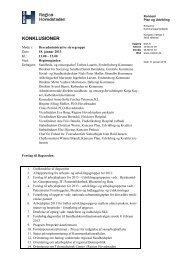Territorial Review Copenhagen - Region Hovedstaden
Territorial Review Copenhagen - Region Hovedstaden
Territorial Review Copenhagen - Region Hovedstaden
You also want an ePaper? Increase the reach of your titles
YUMPU automatically turns print PDFs into web optimized ePapers that Google loves.
53<br />
Potential of a more integrated Øresund economy<br />
The creation of the cross-border Øresund area has been described both<br />
as a gigantic social experiment (Maskell and Törnqvist, 1999) and as an<br />
interesting bench test for regional integration within the European Union<br />
(OECD, 2003). There is little precedent for a merger of two regions, and the<br />
embeddedness of the two regions in their national institutional arrangements<br />
makes it difficult to predict whether integration into one functional region is<br />
feasible, and how quickly it can be accomplished. A clear increase in crossborder<br />
commuting in the Øresund <strong>Region</strong> has run parallel to university cooperation<br />
in the Øresund University, which has received both attention<br />
(OECD, 2003, and OECD/IMHE, 2006) and acclaim (as expressed in a<br />
recent RegioStar EU award to the Øresund Science <strong>Region</strong>). Within the<br />
Øresund <strong>Region</strong>, a considerable overlap of economic and public functions<br />
offers the potential for economies of scale and specialisation. A more<br />
functionally integrated Øresund <strong>Region</strong> could also provide the critical size<br />
that is needed for certain urban amenities and knowledge spillovers that<br />
could attract international business.<br />
1.3 The performance of <strong>Copenhagen</strong><br />
<strong>Copenhagen</strong> scores reasonably well on many economic indicators…<br />
<strong>Copenhagen</strong> has average regional GDP per capita and moderate annual<br />
growth rates. The average GDP per capita in <strong>Copenhagen</strong> in 2005 was US$<br />
32 200, considerably lower than several US metropolitan areas, but<br />
reasonably high compared to other European metropolitan areas, even<br />
though several of them had higher GDP levels, such as Stockholm, Dublin,<br />
Paris and Vienna. The real annual growth rate over 1995-2005 has been<br />
moderate in <strong>Copenhagen</strong> (2.0%), considerably lower than those of several<br />
cities with similar or higher levels of GDP per capita (Figure 1.11), such as<br />
Dublin (8.2%), Stockholm (4.5%), Houston (5.6%) and Washington DC<br />
(4.5%). Within Denmark, <strong>Copenhagen</strong> has experienced the highest growth<br />
rate: over 1997-2006, <strong>Copenhagen</strong>‘s average annual growth rate was around<br />
twice as high as the slowest-growing region in Denmark. <strong>Region</strong>al<br />
disparities between the Capital <strong>Region</strong> and other areas has gradually<br />
increased since 2004, although the differences in growth rates between the<br />
Capital <strong>Region</strong> and regions such as Central and North Jutland were limited<br />
from 1997-2006 (Figure 1.12).

















